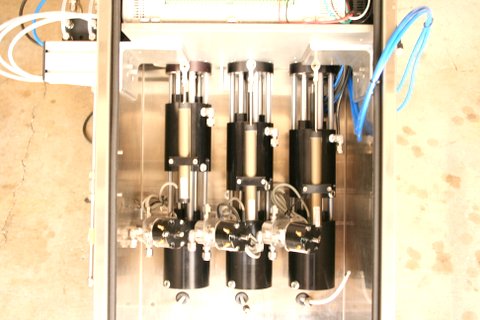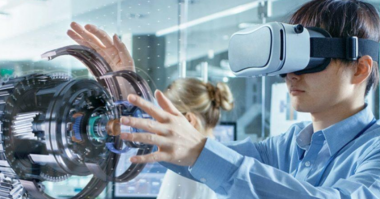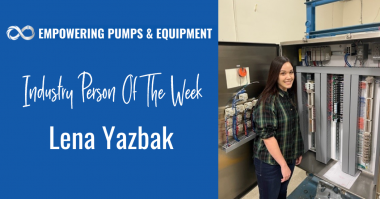Author: Steve Smith, President & Founder, TechValve Industries LLC
What inspires engineers to create new pumps? The inspiration to design new pumps, and even valves and other industrial equipment, stems from seeing a need. A problem to solve. An issue to address. Engineers around the globe spend countless hours engineering solutions to solve the world’s problems.
As a member of the engineering community, I have been inspired to design several pieces of industrial equipment over the years. Eight of my twelve patents are for different pumps and valves, and most of them were created as a result of needing a better solution than what had been available at the time.
For instance, one company I previously worked with originally hand-mixed a two-part silicone gel liquid for a potting process. As that company grew and demand for that company’s product increased, the hand-mixing of that silicone took too much time and people on the assembly line could not keep up with the increase in production. That led me to design and build my first dispense machine.
Initially, I used a programmable logic controller (PLC) along with two gear pumps, but quickly realized that gear pumps were not ideal for the very thick and viscous materials that were being pumped. The next set-up used progressive cavity pumps; and while they were good for low pressure applications, they ended up being incompatible with many of the materials our customers needed to process in other applications. The chemicals attacked the elastomeric portion of the pump stator and caused a lot of problems.
Then I began working with rod pumps, which are very powerful and highly accurate. The only problem with the rod pump was that it did not provide continuous flow. Once all the fluid in the rod pump had been dispensed, the pump had to reverse and refill itself before it could dispense fluid again. This is an issue for any application that cannot have a pause in the pump cycle. Take for example a painting application. A pause in the pump cycle would mean spray is lost and the result would be uneven coverage. Imagine a robot painting the side of a car in an automotive assembly line, and all of a sudden, it runs out of paint. The robot doesn’t know that; it just keeps on going, and now there is an area that hasn’t been covered. Seeing the potential to improve upon rod pump capabilities, I set out to design the world’s first double-acting rod pump.
In 2000, I used AutoCAD to design the dual action rod pump (DARP). From the design phase to having a prototype on the bench took about 30 days. The first prototype of this pump was built in my garage, and initial performance tests proved the DARP worked perfectly. The DARP really gained traction after it was successful in helping an aerospace company with their proprietary metal coating, which had been grinding up every pump they had tried using. The DARP worked great for their application because it could pump anything. There is no metal to metal contact between the pump rod and the fluid cylinder; therefore there is nothing to wear out – no pistons or piston seals, etc. The DARP is essentially a universal pump –
- The DARP is 100% chemically compatible. Over the past 15 years, thousands of our dual acting rod pumps have been used in factory automation applications, aerospace, military, and other industrial processes. To date, there has not been a chemical used that has caused the DARP to degrade or fail. Furthermore, the DARP can “run dry” for extended periods of time without damage or failure.
- The DARP has 100% volumetric efficiency with any viscosity and any pressure. To explain this concept of volumetric efficiency, let’s say you have a gear pump set up next to a piston pump set up next to a dual action rod pump. They’re all the same capacity -they can put out 1 ounce per minute at zero back pressure. Now you turn on the gear pump and give it some back pressure. You see the output drops because it has slip factor (the material can actually slip inside the pump). Instead of dispensing 1 ounce, slip factor might cause that gear pump to only dispense three quarters of an ounce, making that pump only 75% efficient. Air-operated pumps exhibit similar performance issues; i.e. the higher the back pressure, the less output. With the rod pump, there is no change in output. The DARP can dispense one ounce per minute whether the back pressure is 0, 100, 1000, 2000, 3000 or higher. There is no slip factor at any pressure. Let’s say we have 2 dual action rod pumps, and we put water in one and peanut butter in the other one (both with the same capacity). If we ran them both 10 revolutions, we would get the exact same output of water and peanut butter – volumetrically-speaking. The pressure for the DARP pumping peanut butter might be 3000 PSI while the pressure for the DARP pumping water is only 1 or 2 PSI, but the pumps will output 2 ounces of water and 2 ounces of peanut butter. This is the beauty of the DARP – the pressure does not matter because there is no slip factor. The only thing that could stop the DARP are the rotations of the motor that’s driving it. Using a weak motor will stall the pump; this is why we use servo motors to power this pump, which has been tested to handle pressures up to 20,000 PSI.
- It’s a servo-driven “smart” pump. Servo motors provide high accuracy metering and our proprietary remote controllers are customized for the end user and the specific application the dual action rod pump will be operating in. The DARP is truly a smart pump because the controller knows what the pump is capable of. It won’t allow the operator to perform an action that the pump is not capable to perform. The controller knows how to control the pump based on whatever the operator is asking the pump to do.
This smart pump presents a great opportunity for the bio-tech industry. We’ve spent the last 3 years working on a whole new generation of dual action rod pumps that specialize in really low flow. This new DARP is capable of dispensing extremely small quantities of fluid over very long periods of time without any pulsations. The biotech industry (this includes companies developing new medicines and labs conducting cancer research) has spent years scrapping “bad samples” because the peristaltic pumps they typically rely on to dispense fluid create pulses during operation. Now there is an alternative – an engineered solution to help improve micro-fluidic processes within the biotech industry.
The DARP provides a solution for preventing a “bump” in the dispense routine. A “bump” is generally an upset in the flow of fluid, which is typically caused by the pump changing direction or experiencing a fluctuation in pressure. Reciprocating pumps can’t handle a change of direction in a dispense routine. Gear pumps pulse with every gear shift and exhibit high frequency fluctuations in output, as do progressive cavity pumps. The upset in the flow that can happen in the middle of a sample is a major issue for the biotech industry, and the DARP addresses all those issues.
The DARP provides continuous flow and never changes direction in the middle of a sample. This “smart” pump knows when it has reached the point where it cannot create one full sample. At this point, the control screen tells the operator that it cannot produce more samples until the pump changes direction. Once prompted by our proprietary software, the operator needs only to press a button to allow the pump to change direction and produce another set of samples. The controller will only allow the pump to go as far as it can go to finish the last routine, but it won’t start another routine it can’t finish without changing direction. For example, if the pump is reaching the end of its stroke, and it has been asked to provide a 10cc output, but it is only capable of dispensing 8cc’s – it won’t dispense 8cc’s. The DARP will stop and an alert notice will appear on the screen telling the operator that they have reached the limit of output for that stroke. The operator is then allowed to initiate the change of direction to ensure the same amount of dispense routines goes in the other direction. This way there will never be a change of direction in the middle of a sample.
We see many opportunities for the Dual Action Rod Pump to have a positive impact in a wide range of applications. Visit www.techvalveind.com to watch a video of the DARP pump in action!
About the Author
Currently the Co-Program Director and Principal Investigator for California Cardiac Solutions, LLC., Steve Smith has over 12 years’ experience as a Director of Mechanical Engineering; having worked with factory automation, robotics, CNC/PLC computer controls and servo drive systems. Smith holds numerous patents and has 22 years of experience in the design, development, and manufacturing of high precision fluid metering systems and fluid control circuits.
For more information, contact Steve Smith atssmith@techvalveind.com, or his associate, Glenn Dietz gdietz@kzagroup.com.





Comments